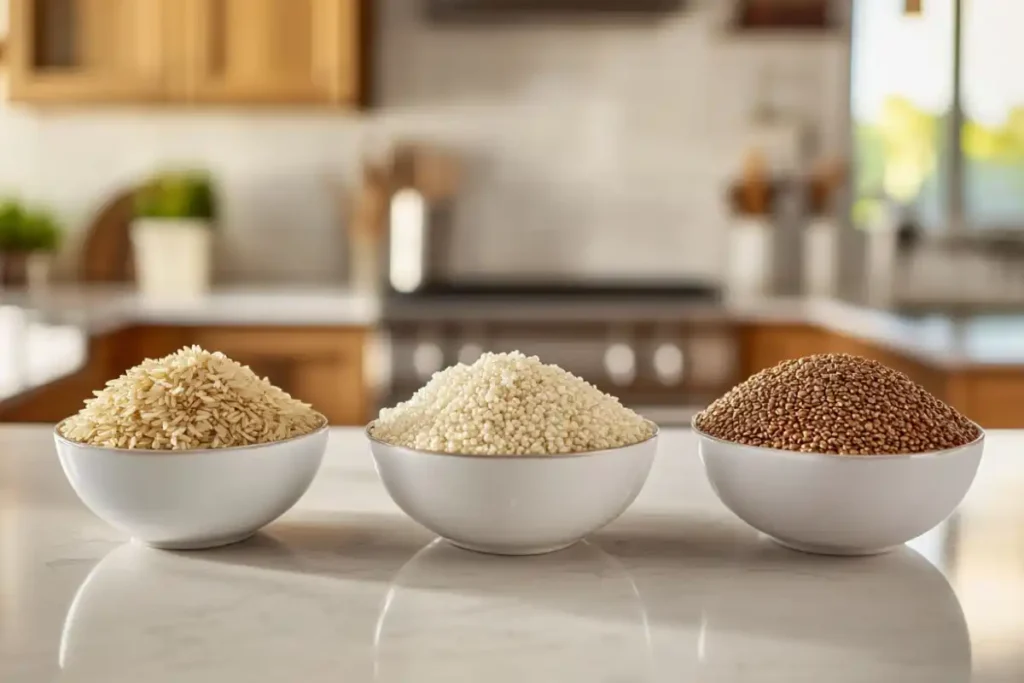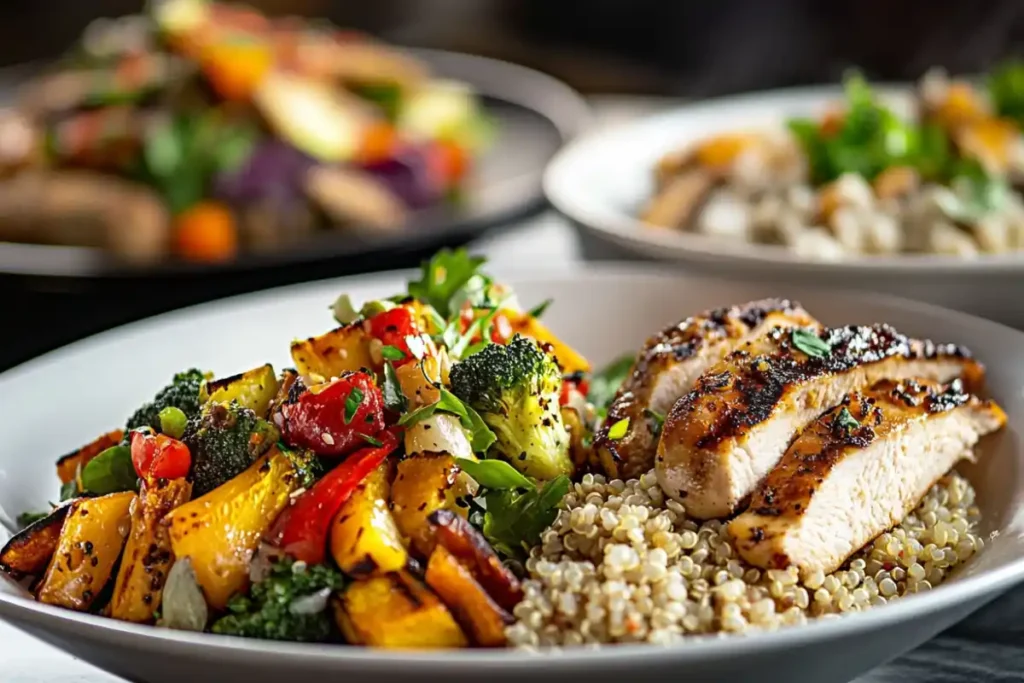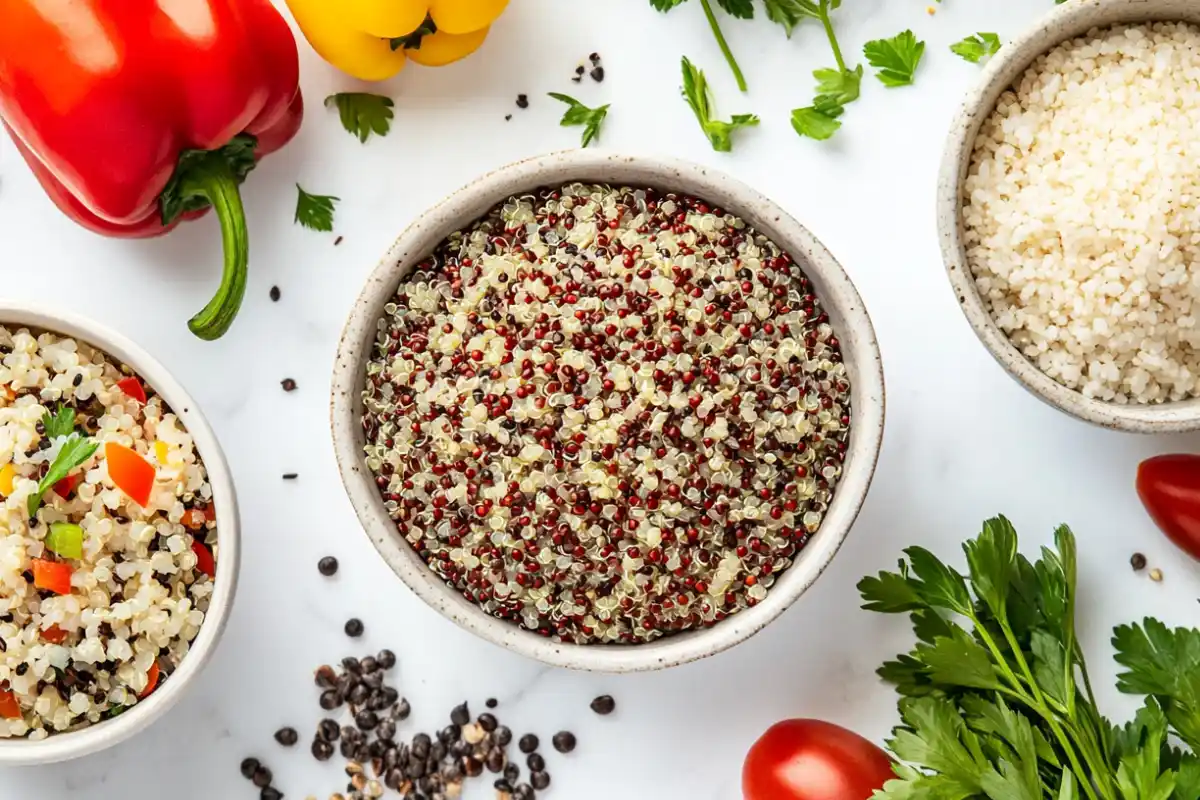Rice has been a dietary staple for centuries, feeding billions worldwide. But in recent years, quinoa has emerged as a so-called “superfood,” leading many to ask: Is quinoa better than rice? The answer isn’t as simple as it seems.
Both have their own unique benefits, from nutrition to taste, digestibility, and even sustainability. Whether you’re looking to lose weight, control blood sugar, or just eat healthier, knowing how these two compare can help you make an informed choice.
In this article, we’ll break down the key differences, covering nutrition, health benefits, weight loss, cooking methods, and environmental impact. By the end, you’ll know which one suits your lifestyle best!
Introduction
What Are Quinoa and Rice?
At first glance, quinoa and rice seem pretty similar—they’re both commonly used grains that serve as a base for countless dishes. However, they come from completely different plant families.
- Quinoa (Chenopodium quinoa) is actually a seed—often called a “pseudograin”—that originates from South America. It’s been a staple in the Andean diet for thousands of years.
- Rice (Oryza sativa) is a true grain that has been cultivated for over 10,000 years in Asia and beyond. It’s one of the most widely consumed foods in the world.
Why Compare Quinoa and Rice?
With the rise of health-conscious eating, many are swapping out white rice or even brown rice for quinoa. But is it really the better choice?
- Some say quinoa is a healthier alternative because it’s higher in protein and fiber.
- Others argue that rice, especially brown rice, is just as nutritious, more affordable, and easier to cook.
- Diet preferences also play a role—those following gluten-free, low-carb, or plant-based diets might prefer one over the other.
So, which one should you choose? To answer that, let’s dive into their nutritional breakdown, health benefits, and overall impact on your diet.
Nutritional Comparison
When choosing between quinoa and rice, nutrition is one of the most important factors to consider. While both are popular grain-based foods, their macronutrient and micronutrient profiles set them apart. So, is quinoa better than rice in terms of nutrition? Let’s compare the two.

Macronutrient Breakdown
- Protein Content
One of quinoa’s standout features is its high protein content. A 1-cup serving of cooked quinoa contains around 8 grams of protein, whereas white rice provides only 4 grams and brown rice has about 5 grams. What’s even more impressive? Quinoa is a complete protein, meaning it contains all nine essential amino acids—something rare in plant-based foods. This makes it an excellent choice for vegetarians and vegans looking to increase their protein intake. - Carbohydrates and Fiber
When it comes to carbohydrates, white rice is the highest, with about 45 grams per cup, while quinoa contains around 39 grams. However, the key difference is fiber content.- Quinoa: 5 grams of fiber per cup
- Brown rice: 3.5 grams per cup
- White rice: 0.6 grams per cup
- Fat and Healthy Fats
While neither food is high in fat, quinoa contains heart-healthy omega-3 fatty acids, which can help reduce inflammation and support brain health.
Micronutrient Differences
Quinoa also outperforms rice in terms of vitamin and mineral content.
- Quinoa is rich in:
- Iron (essential for oxygen transport)
- Magnesium (supports muscle and nerve function)
- Zinc (boosts immune health)
- Folate (important for cell growth, especially during pregnancy)
- Rice, particularly brown rice, contains:
- B vitamins (helpful for energy production)
- Manganese (important for metabolism)
- Selenium (supports thyroid function)
Final Verdict: Which One Wins?
If you’re looking for better overall nutrition, quinoa is the clear winner due to its higher protein, fiber, and micronutrient content. However, brown rice is still a healthy alternative, especially for those who prefer a more affordable and widely available grain.
Health Benefits
Beyond nutrition, it’s important to ask: Is quinoa better than rice for overall health and well-being? Let’s explore how each affects digestion, weight management, and long-term health.
Digestive Health and Fiber Content
When it comes to gut health, fiber is essential. Quinoa leads the way, with 5 grams of fiber per cup, compared to 3.5 grams in brown rice and less than 1 gram in white rice.
- More fiber means better digestion. It helps prevent constipation, supports a healthy gut microbiome, and promotes regular bowel movements.
- Lower fiber intake, like in white rice, can lead to blood sugar spikes and digestive issues.
For those looking to improve digestion, quinoa is the best option.
Impact on Weight Loss and Satiety
If you’re trying to lose weight, choosing foods that keep you full longer is key.
- Quinoa’s high protein and fiber make it more filling than rice, meaning fewer cravings and better portion control.
- Brown rice is a decent alternative, but it lacks the complete protein profile that quinoa offers.
- White rice, with its high glycemic index, can cause blood sugar spikes, leading to hunger sooner after eating.
A diet rich in high-protein and high-fiber foods is linked to better weight management, making quinoa a stronger choice for those focused on fat loss.
Long-Term Health Benefits
Quinoa’s nutrient density makes it great for heart health, diabetes management, and reducing inflammation.
- Heart Health: The omega-3s and antioxidants in quinoa help reduce cholesterol and blood pressure, lowering the risk of heart disease.
- Diabetes Control: Quinoa has a lower glycemic index than white rice, making it better for blood sugar control.
- Inflammation Reduction: Thanks to its plant-based antioxidants, quinoa may help fight chronic diseases.
Final Verdict: Healthier Option?
If you prioritize digestion, weight management, and long-term health, quinoa is superior to white rice and slightly better than brown rice. However, both quinoa and brown rice can be part of a balanced, healthy diet.
Different Diets and Health Goals
Not everyone has the same dietary needs, and the choice between quinoa and rice often depends on personal health goals and restrictions. So, is quinoa better than rice for certain diets? Let’s break it down.
Gluten-Free and Allergen Considerations
For those with gluten intolerance or celiac disease, both quinoa and rice are safe choices since they are naturally gluten-free. However, quinoa offers additional benefits:
- Quinoa is less processed, meaning it’s less likely to be cross-contaminated with gluten compared to some rice-based products.
- Some people with grain allergies find quinoa easier to digest than rice, particularly white rice.
If you’re following a strict gluten-free diet, quinoa might be the safer and more nutritious choice.
Diabetes and Blood Sugar Control
When managing diabetes or insulin resistance, choosing foods with a lower glycemic index (GI) is important.
- White rice has a high GI, meaning it can cause blood sugar spikes.
- Brown rice is a better option due to its fiber content, but still has a moderate GI.
- Quinoa has the lowest GI, making it the best choice for keeping blood sugar levels stable.
If you’re diabetic or trying to maintain steady energy levels, quinoa is the better choice over white rice and slightly better than brown rice.
Culinary Uses: How to Cook and Eat Quinoa vs. Rice
Beyond nutrition, knowing how to cook and use these grains in meals is just as important. Let’s compare how quinoa and rice perform in the kitchen.
Cooking Methods and Preparation
Both are easy to prepare, but there are some differences in cooking methods.
- Quinoa cooks faster than rice, taking about 15 minutes compared to 20-45 minutes for rice (depending on the variety).
- Quinoa needs rinsing before cooking to remove its natural bitter coating (saponins).
- White rice is the easiest to cook, while brown rice requires more water and a longer cooking time.
If you want a quick and nutritious side dish, quinoa is a faster and healthier option.
Best Dishes and Recipes
Both can be used in a variety of dishes:
- Best uses for quinoa: Salads, grain bowls, stir-fries, and protein-packed breakfasts.
- Best uses for rice: Sushi, curries, casseroles, and traditional side dishes.

If you’re looking for versatility and nutrition, quinoa is more adaptable to different diets and meals.
Environmental Impact and Sustainability
In today’s world, sustainability matters just as much as nutrition. If you’re wondering, is quinoa better than rice from an environmental standpoint, the answer depends on several factors, including water usage, farming practices, and carbon footprint.
Quinoa Farming vs. Rice Farming
- Water Consumption: Rice farming is highly water-intensive. It takes around 2,500 liters of water to produce 1 kilogram of rice, whereas quinoa requires significantly less.
- Soil Health: Rice paddies often contribute to soil degradation and depletion, while quinoa can be grown in harsh, nutrient-poor soils without excessive fertilizers.
- Methane Emissions: Rice cultivation produces large amounts of methane, a potent greenhouse gas. In contrast, quinoa farming has a much lower environmental footprint.
Carbon Footprint Comparison
- Rice production contributes to climate change due to its high methane emissions and energy-intensive processing.
- Quinoa is mostly grown in South America, which means it often has a larger transportation footprint when shipped globally. However, its overall carbon footprint is still lower than rice.
Final Verdict: The More Sustainable Choice
Quinoa is more environmentally friendly than rice due to its lower water usage, reduced methane emissions, and better soil sustainability. However, choosing locally sourced options for both can help minimize their impact on the planet.
Which One Should You Choose?
Now that we’ve compared nutrition, health benefits, cooking methods, and sustainability, the big question remains: is quinoa better than rice for you?
Best Option for Different Lifestyles
- For high-protein diets: Quinoa wins. It’s a complete protein, making it a great choice for vegetarians, vegans, and athletes.
- For easy digestion: Quinoa has more fiber, making it better for gut health and blood sugar control.
- For affordability and tradition: Rice is cheaper and more accessible in many parts of the world. Brown rice is a healthier alternative to white rice.
- For sustainability: Quinoa has a lower carbon footprint and water usage than rice.
The Final Choice
If you prioritize nutrition, digestion, and sustainability, quinoa is the better choice. However, brown rice remains a good, budget-friendly option for those who prefer traditional grains.
FAQs – People Also Ask
Many people have questions when comparing quinoa and rice. Below are answers to some of the most common queries.
1. Is quinoa better than rice for weight loss?
Yes! Quinoa is higher in protein and fiber, which helps keep you full for longer. Unlike white rice, which can cause blood sugar spikes and hunger soon after eating, quinoa provides sustained energy and better appetite control. If weight loss is your goal, quinoa is a smarter choice.
2. Can quinoa replace rice in every meal?
Mostly, yes. You can swap quinoa for rice in dishes like stir-fries, salads, and grain bowls. However, rice has a softer, stickier texture, making it better for sushi or certain traditional dishes.
3. Which type of rice is the healthiest?
Brown rice is the healthiest rice option because it contains more fiber, vitamins, and minerals than white rice. However, quinoa still has more protein and a lower glycemic index, making it an even better choice nutritionally.
4. Does quinoa have more protein than rice?
Yes! Quinoa contains 8 grams of protein per cup, while white rice has 4 grams and brown rice has 5 grams. Quinoa is also a complete protein, meaning it has all nine essential amino acids, unlike rice.
Conclusion
So, is quinoa better than rice? For most people, yes!
- Quinoa is more nutritious, packed with protein, fiber, and essential vitamins.
- It has a lower glycemic index, making it better for blood sugar control.
- It’s more filling, making it a great option for weight management.
- It’s more sustainable, requiring less water and producing fewer emissions than rice.
That said, brown rice is still a healthy and affordable alternative, especially for those who prefer a more familiar texture and taste.
Final Thought
If you’re looking for a healthier, more nutrient-dense grain, quinoa is the winner. But if you prefer a more budget-friendly and widely available option, brown rice is a solid choice.
Would you make the switch? Try incorporating both into your diet and enjoy their unique benefits! 🚀
